Water-based exercises suit all mobility levels by reducing joint stress through buoyancy. You’ll find options ranging from gentle water walking for beginners to advanced deep water bicycling for core strength. Pool lifts, flotation devices, and adaptive equipment make swimming accessible even with severe limitations. Warm water therapy offers pain relief while group activities foster social connections. Mental health benefits include reduced anxiety and improved self-esteem. The following guide explores exercises that can transform your mobility journey regardless of your starting point.
Numeric List of Second-Level Headings

Five distinct exercise categories form the foundation of our pool workout program.
You’ll find exercises organized by mobility level and specific fitness goals:
- Beginning Mobility Exercises – Simple movements like water walking and marching that build fundamental strength and confidence in the water. These exercises are low-impact and particularly beneficial for seniors with arthritis or chronic pain.
- Intermediate Mobility Exercises – More challenging activities including aqua jogging and leg lifts that develop balance and coordination.
- Advanced Mobility Exercises – Complex movements such as deep water bicycling and pool planks that maximize core strength and endurance.
- Flexibility and Balance Exercises – Targeted movements like one-leg stands and torso twists that improve range of motion and stability.
- Rehabilitation and Recovery Exercises – Gentle techniques designed to support healing while maintaining fitness during recovery periods.
Why Water-Based Movement Benefits Those With Limited Mobility
Now that you’re familiar with our exercise categories, let’s explore why the pool offers such extraordinary advantages for those with mobility challenges.
Water’s natural buoyancy reduces joint stress, making movement less painful while still providing resistance that builds strength.
You’ll experience improved range of motion as water supports your body through movements that might be difficult on land. This is particularly valuable if you’re recovering from surgery or managing conditions like arthritis or Parkinson’s.
Beyond physical benefits, water-based exercise improves your mental wellbeing. The calming properties of water reduce anxiety, while group sessions combat isolation. Many participants find that pool activities create an environment for social connections and friendships that extend beyond exercise time.
The hydrostatic pressure helps manage pain by reducing inflammation and swelling, creating a comfortable environment where you can move freely. Water truly transforms exercise into an accessible, enjoyable experience.
Essential Adaptive Equipment for Pool Accessibility
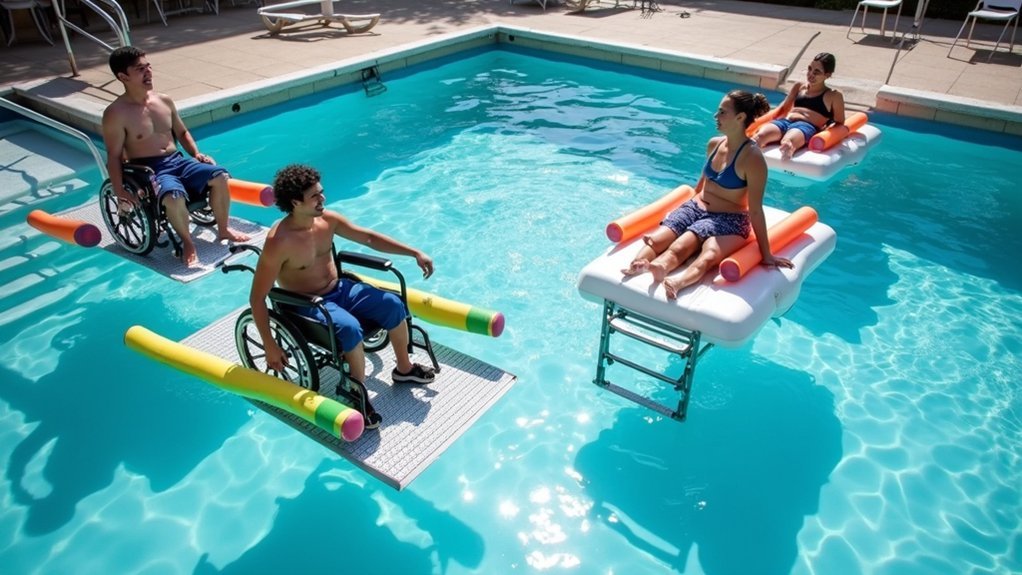
Making your pool accessible starts with essential equipment like pool lifts that provide secure transfers for mobility-impaired swimmers. Pool lifts ensure equal access and inclusivity in recreational environments while eliminating barriers for the 12.1% of U.S. adults with serious mobility difficulties.
You’ll find underwater mobility aids vital for maintaining proper body position and enhancing independence during water exercises.
Flotation support systems, including adjustable vests and belts, can be customized to your specific needs while offering the stability required for effective therapeutic movements.
Accessible Pool Lifts
When considering accessible swimming environments, pool lifts represent one of the most essential innovations for individuals with mobility challenges.
These devices guarantee safe, independent entry and exit from the water, creating truly inclusive recreational spaces. Modern pool lifts are designed to accommodate a wide range of mobility challenges, featuring adjustable seat heights and rotating seats.
You’ll find several types of lifts available to meet different needs, including permanent installations, portable options, and battery-powered models.
Each provides unique benefits depending on your facility requirements and user needs.
- Safety first – Properly installed lifts prevent dangerous falls and accidents
- Independence restored – Users can enjoy the water without relying on others
- Dignity preserved – No more awkward transfers or embarrassing situations
- Community strengthened – Everyone can participate in aquatic activities together
Remember that effective lifts feature user-friendly controls, appropriate weight capacity, and stability during transfers.
Underwater Mobility Aids
Beyond pool lifts, underwater mobility aids open up a world of aquatic freedom for individuals with differing abilities. You’ll find specialized equipment designed with non-corrosive materials that resist water damage while providing essential support during your pool sessions. Modern transfer systems, like the SureHands® lift, require only one attendant for safe and efficient operation from wheelchair to water.
| Aid Type | Key Feature | Benefit |
|---|---|---|
| Pool Wheelchairs | Mesh seating | Quick-drying comfort |
| Transfer Systems | Minimal assistance needed | Enhanced independence |
| Flotation Devices | Custom-fit options | Personalized buoyancy support |
| Handrails | Sensory textures | Improved grip in wet environments |
When selecting underwater mobility aids, consider how they’ll complement your specific needs. Many devices require little installation and adapt to existing pool settings. The right combination of support features—from gradual entry ramps to specialized flotation belts—can greatly improve your confidence and safety during water activities.
Flotation Support Systems
Flotation support systems serve as the backbone of accessible pool experiences for individuals across all mobility spectrums.
Whether you’re recovering from an injury or managing a long-term condition, these adaptive tools provide the buoyancy and stability needed to engage confidently in water-based exercises.
- Freedom in movement – Experience the liberating feeling of exercising without the limitations often felt on land
- Renewed confidence – Transform anxiety about water activities into empowerment with customizable support
- Independent participation – Take control of your fitness journey with equipment you can adjust to your changing needs
- Community connection – Join group classes with proper flotation support, breaking isolation barriers
These systems, ranging from simple noodles to specialized vests, can be used under professional guidance to maximize safety and therapeutic benefits. The integration with movable pool floors creates a comprehensive accessibility solution that adapts to users’ changing needs and abilities.
Getting Started: Pool Entry Techniques for Wheelchair Users
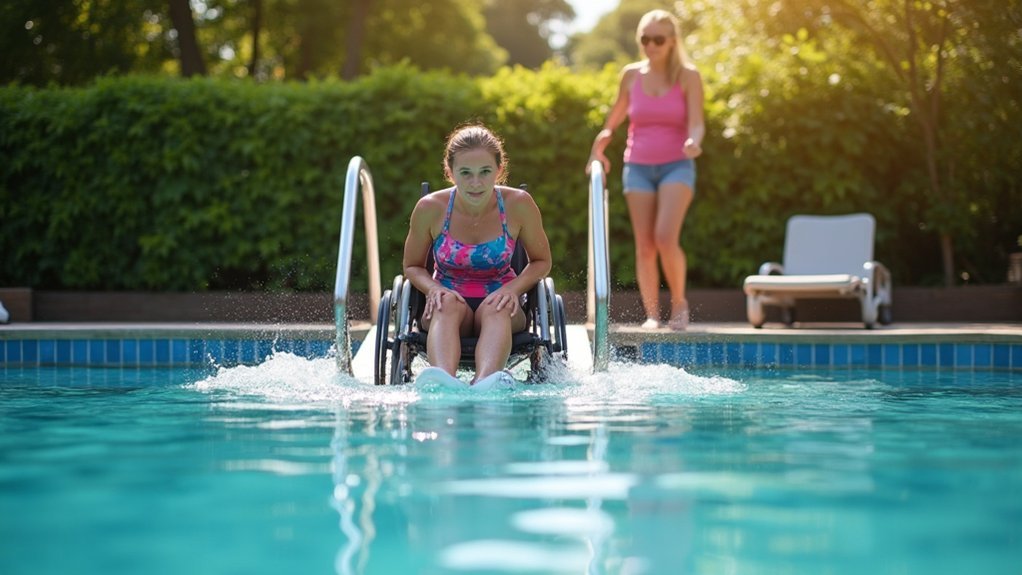
Choosing the right entry method for your pool experience can transform accessibility challenges into empowering opportunities.
You’ll find multiple options including pool lifts, hoists, and transfer walls that accommodate different strength levels and mobility needs.
Consider working with pool staff to identify which assistive devices—whether manual or powered—will best support your transfer technique while maintaining safety and independence.
Once in the water, you can take advantage of water buoyancy to make movements easier and less stressful on your joints.
Transfer Techniques
For wheelchair users, accessing a swimming pool requires specialized transfer techniques that prioritize both safety and dignity.
You’ll need to choose the method that works best for your mobility level, whether that’s using a pool lift, transfer wall, or standing transfer with support.
- Pool hoists and lifts provide the most support, allowing you to transfer directly from your wheelchair into the water with minimal physical exertion.
- Transfer walls empower you to independently shift by pivoting yourself from wheelchair to water.
- Aquatic wheelchairs protect your personal mobility device while maintaining your freedom poolside.
- Standing transfers may work if you have some weight-bearing ability, using rails and assistance for stability.
Communication with pool staff about your preferred transfer method guarantees you’ll receive appropriate support while maintaining independence. A gentle sloping entrance in pools improves safety by preventing slips and falls during transfers.
Entry Accessibility Options
When you’re ready to enjoy water-based exercise, the method you use to enter the pool greatly impacts your overall experience. For wheelchair users, several options guarantee safe, dignified access to the water.
| Entry Method | Benefits | Considerations |
|---|---|---|
| Pool Lifts | Independent entry, fixed or portable options | Requires regular maintenance |
| Ramps/Sloped Entries | Gradual entry while remaining in wheelchair | Needs substantial space |
| Transfer Walls | Allows change from wheelchair to pool edge | Upper body strength needed |
You’ll find aquatic wheelchairs particularly helpful as they’re designed for water use without contaminating the pool. Some individuals may require access to wet-side wheelchairs for easier transfers from changing rooms to poolside. Don’t hesitate to ask staff about your preferred entry method—this guarantees your comfort and safety. Remember that properly installed accessibility features not only prevent injuries but create an inclusive environment where everyone can enjoy the therapeutic benefits of water exercise.
Assistive Devices Explained
Since entering the water safely remains a primary concern for wheelchair users, understanding available assistive devices can transform your pool experience. Many facilities offer specialized equipment designed specifically for accessible water entry and enjoyable swimming.
- Pool lifts and hoists provide independent access by safely lowering you from your wheelchair directly into the water, some featuring remote controls or wristbands for self-operation.
- Transfer systems and walls offer stability and support during the wheelchair-to-water changeover, complete with safety rails for increased confidence.
- Floatation devices like vests, kickboards, and pool noodles enhance your buoyancy once in the water, allowing greater freedom of movement.
- Human guides can provide personalized support for those new to aquatic activities, ensuring safety while you build comfort in the water. All public swimming pools must include at least one accessible entry according to the 2010 Revised ADA Standards.
Gentle Water Therapy Exercises for Severe Mobility Restrictions
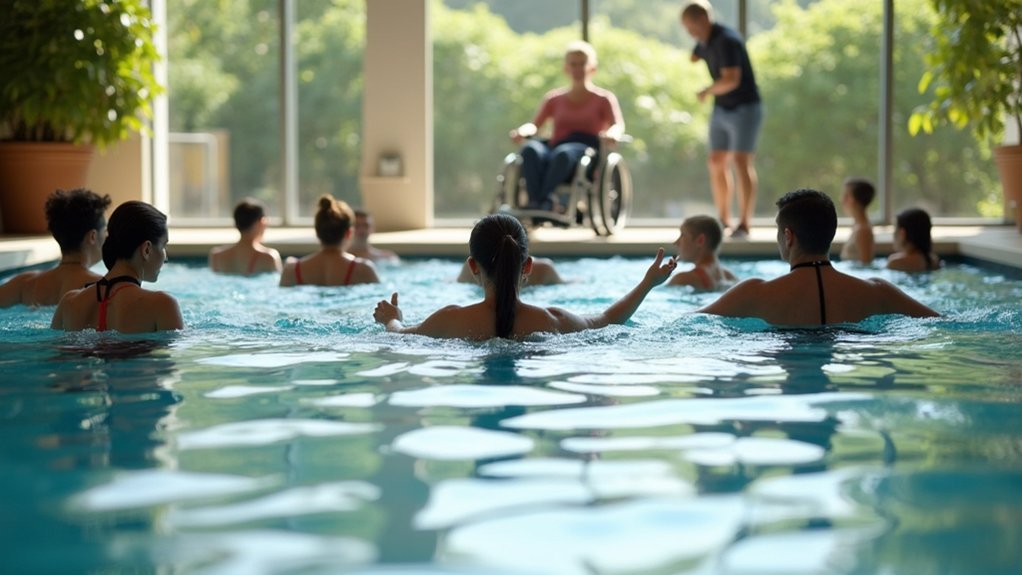
While traditional exercise can be challenging for those with severe mobility limitations, water therapy offers a uniquely supportive environment where healing becomes possible. Water’s buoyancy supports up to 90% of your body weight, dramatically reducing stress on painful joints and bones.
Begin with gentle walking exercises—forward, backward, and side-to-side—in shallow water. As you gain confidence, try seated leg lifts and multi-directional leg kicks to build strength. Use floatation devices like noodles or life jackets for additional support when needed.
Water therapy particularly benefits conditions like arthritis, osteoporosis, and post-surgical recovery. The warm water environment reduces pain while hydrostatic pressure improves circulation to aid healing. For patients with spinal stenosis, aquatic exercises facilitate the return of motor abilities and can significantly enhance gait without putting stress on the body.
You’ll appreciate the reduced fall risk as you gradually progress at your own pace.
Chair-Based Pool Movements for Balance and Coordination
Chair-based pool exercises provide an excellent solution for those seeking to improve balance and coordination with additional support. The buoyancy of water reduces fall risk while allowing you to work on stability through movements like seated marches and leg lifts.
The therapeutic embrace of water offers chair-supported stability training in a safe, fall-resistant environment perfect for rebuilding confidence.
- Water Walking: Feel the gentle resistance as you walk in shallow water, engaging your core while the chair remains nearby for security if needed. The natural water resistance helps strengthen muscles while providing a safer environment than land-based exercises.
- Seated Leg Lifts: Experience the satisfaction of strengthening your legs while safely seated, promoting better coordination for daily activities.
- Tandem Walking: Build confidence as you practice heel-to-toe walking with chair support, gradually improving your natural balance.
- Single-Leg Balance: Celebrate small victories as you progress to standing on one leg while using the chair for stability when necessary.
Progressive Strength Building Through Water Resistance
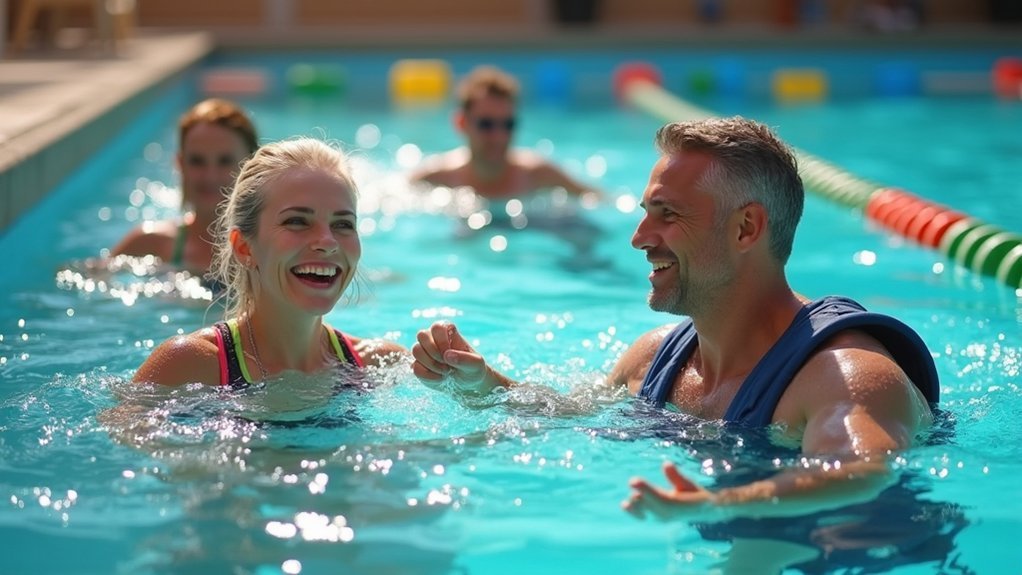
Building strength in water offers unique advantages that land-based exercises simply can’t match. The natural resistance of water provides multidirectional challenges while its buoyancy reduces joint stress, making it ideal for all mobility levels.
To progressively build strength, increase your movement speed—moving faster can quadruple resistance. Start with basic aquatic lunges and water jogging, then incorporate resistance bands or weighted equipment as you advance.
The water’s hydrostatic pressure guarantees your muscles work harder with each movement.
Remember to focus on controlled movements and proper form. The water allows you to engage stabilizing muscles for more controlled strength development without risking injury. The water’s cooling properties will allow you to train longer, while the increased time under tension improves neuromuscular coordination.
For best results, gradually increase repetitions or speed to maintain the progressive overload principle essential for continued strength development.
Aquatic Exercises for Managing Chronic Pain Conditions
For those suffering from chronic pain conditions, aquatic exercises offer a therapeutic haven where movement becomes possible again. The water’s buoyancy reduces joint stress while providing gentle resistance, making it ideal for arthritis, fibromyalgia, and chronic back pain management.
- Feel freedom again as water supports your body, allowing pain-free movement that’s impossible on land.
- Reclaim your independence through strengthening exercises that improve daily functioning.
- Experience the joy of movement without fear of pain or injury triggering flare-ups.
- Rediscover community by joining classes where others understand your challenges.
Warm water therapy particularly benefits those with inflammatory conditions, as it combines hydrostatic pressure to reduce swelling with thermal effects that relax tight muscles and improve circulation. Licensed physical therapists can create personalized therapy plans to address your specific pain points and recovery goals.
Mental Health Benefits of Water-Based Movement Therapy
While the physical advantages of pool exercises are well-documented, the profound mental health benefits deserve equal attention.
When you immerse yourself in water-based activities, you’re not just strengthening your body—you’re enhancing your mental wellbeing too.
Research shows that aquatic exercises considerably reduce symptoms of depression, anxiety, and stress by releasing mood-boosting endorphins.
Dive into wellness as water workouts wash away depression and anxiety through the natural flow of endorphins.
You’ll likely notice improved self-esteem and reduced feelings of social stigma, particularly if you’re managing conditions like depression or schizophrenia.
The buoyancy of water creates a uniquely calming sensory experience that promotes mental wellness.
Joining group water classes can also combat isolation by fostering social connections and community engagement.
Even better, these benefits extend to all mobility levels, making pool therapy an accessible option for ongoing mental health support.
The remarkable benefits of water-based physical activity have been thoroughly documented in the Thalassa Project, which studied over 100 participants across a two-year period.
Group Activities for Social Connection in Adaptive Swimming
Beyond merely exercising, adaptive swimming creates powerful opportunities for social connection and community building.
When you participate in water-based group activities, you’ll find that the supportive environment encourages engagement across varying abilities. The buoyancy of water creates a level playing field where everyone can interact freely without fear of injury. Aquatic settings have shown significant benefits for autistic children, improving their social behaviors while reducing typical autism behaviors.
- Join underwater relay races to build teamwork skills while developing stronger bonds with fellow swimmers.
- Participate in adapted synchronized swimming routines to experience the joy of coordinated movement with others.
- Engage in water yoga sessions where shared mindfulness practices can reduce anxiety and foster meaningful connections.
- Try team competitions tailored to different abilities to celebrate achievements together while building lasting friendships.
Measuring Progress: Achievable Milestones in Water Therapy
You’ll see tangible results from your water therapy through tracking specific measurements like increased repetitions of resistance exercises and improved balance test scores.
Setting weekly endurance goals helps you build cardiovascular strength gradually, whether you’re adding five minutes to your swimming time or completing additional laps.
Your progress journal should document mobility improvements, such as greater range of motion in affected joints or reduced assistance needed for daily activities. Monitoring water quality is essential as water pollution can impact health outcomes and therapy effectiveness.
Tracking Strength Gains
Consistent measurement of progress forms the backbone of effective water therapy.
You’ll discover tangible improvements when you routinely evaluate your strength gains using water-specific assessment tools. Resistance band exercises provide excellent metrics for upper and lower body development, while timed activities reveal endurance improvements. Setting specific objectives for desired outcomes such as strength improvement helps maintain focus throughout your water therapy journey.
- Watch your reps increase – There’s nothing more satisfying than doubling the repetitions you could perform when you first started.
- Feel resistance becoming easier – What once felt impossible becomes your warm-up.
- Notice everyday activities becoming effortless – Climbing stairs or lifting groceries suddenly requires minimal effort.
- Track your recovery time – See your breathing and heart rate normalize faster between exercises.
Regular strength assessments help you adjust workout intensity and prevent plateaus, keeping your aquatic fitness journey progressive and rewarding.
Mobility Improvement Markers
Recognizing the markers of mobility improvement provides essential validation for anyone committed to aquatic therapy.
You’ll notice significant progress through standardized assessments like the Timed Up and Go Test, which effectively measures your functional mobility changes over time.
Watch for improvements in your balance and gait—key indicators that your water exercises are working. You’ll likely experience better coordination during standing, walking, and shifting movements, with research showing aquatic therapy participants outperform those doing land-based exercises.
Your quality of life measurements matter too. Tools like the PDQ-39 scale can track reductions in anxiety, depression, and pain levels.
As you continue your aquatic program, expect enhanced physical and emotional well-being, decreased fall risk, and greater confidence in everyday movements—all measurable signs of your success. The reduced joint load from water’s buoyancy allows for comfortable exercise progression that may not be possible on land.
Weekly Endurance Goals
Setting effective endurance goals transforms your aquatic therapy from a collection of exercises into a structured journey of measurable progress.
Begin by establishing your baseline through initial testing—whether that’s counting laps or timing your water aerobics sessions. From there, aim to increase your capacity by about 10% each week.
- Track your heart rate during workouts to witness your body’s improving efficiency—nothing feels more rewarding than seeing those numbers change!
- Mix up your routine with water jogging or aqua aerobics to challenge your endurance in different ways. The low joint impact of water exercises makes them particularly suitable for gradually building endurance without risking injury.
- Monitor your hydration before and after sessions—proper fluid balance dramatically affects your performance.
- Celebrate each milestone you reach, whether it’s completing more laps or extending your workout time.
Year-Round Options: Indoor vs. Outdoor Adapted Pool Programs
When deciding between indoor and outdoor adapted swimming programs, you’ll need to contemplate how seasonal changes affect accessibility and consistency.
Indoor facilities like Provo City’s Recreation Center offer year-round adaptive lessons, private instruction, and competitive opportunities through programs like Adaptive Piranhas Swim Team.
Outdoor programs provide seasonal options that incorporate natural sunlight but require additional safety measures for UV exposure. They’re typically available only during warmer months and may not offer the all-encompassing structure of indoor programs.
For continuous skill development, indoor pools provide consistent access regardless of weather conditions. These environments create safe and inclusive spaces where individuals with various disabilities can develop aquatic skills at their own pace.
Many facilities like Chomper’s Swim School offer flexible scheduling options to accommodate your needs, with programs structured around functioning levels and individualized assessments to guarantee appropriate placement.
Frequently Asked Questions
How Deep Should the Water Be for Different Mobility Levels?
For different mobility levels, you’ll need chest-deep water for beginners and those with joint issues, waist-high for seniors starting exercises, and at least 6 feet for advanced, deepwater workouts without floor contact.
Can Medications Affect Safety During Pool Exercises?
Yes, medications can affect your safety during pool exercises. They may cause dizziness, dehydration, muscle cramps, or reduced coordination. Always consult your doctor about how your specific medications might impact water activities.
What Water Temperature Is Optimal for Therapeutic Exercises?
For most therapeutic exercises, you’ll find 89°F to 94°F (32°C to 34°C) ideal. If you have arthritis, aim for 84°F to 88°F. Remember, your specific condition and exercise intensity may require temperature adjustments.
Should I Eat Before My Water Workout Session?
Yes, you should eat 1-2 hours before your water workout. Have a light carb-rich snack like a banana or yogurt for energy. Don’t worry about cramping – that’s a myth that’s been debunked.
How Do Chlorine and Other Chemicals Impact Sensitive Skin Conditions?
Chlorine can worsen your sensitive skin by stripping natural oils, causing dryness, irritation, and flare-ups of conditions like eczema and psoriasis. Consider using protective moisturizers or alternatives like saltwater pools for gentler treatment.
In Summary
You’ll find that pool exercises provide unique benefits regardless of your mobility level. With proper equipment and techniques, you’re never excluded from the water’s therapeutic embrace. As you’ve seen, these activities improve both physical function and mental wellbeing. Start where you are, measure your progress, and enjoy the social connections you’ll make. Whether indoors or outdoors, water therapy can transform your health journey year-round.

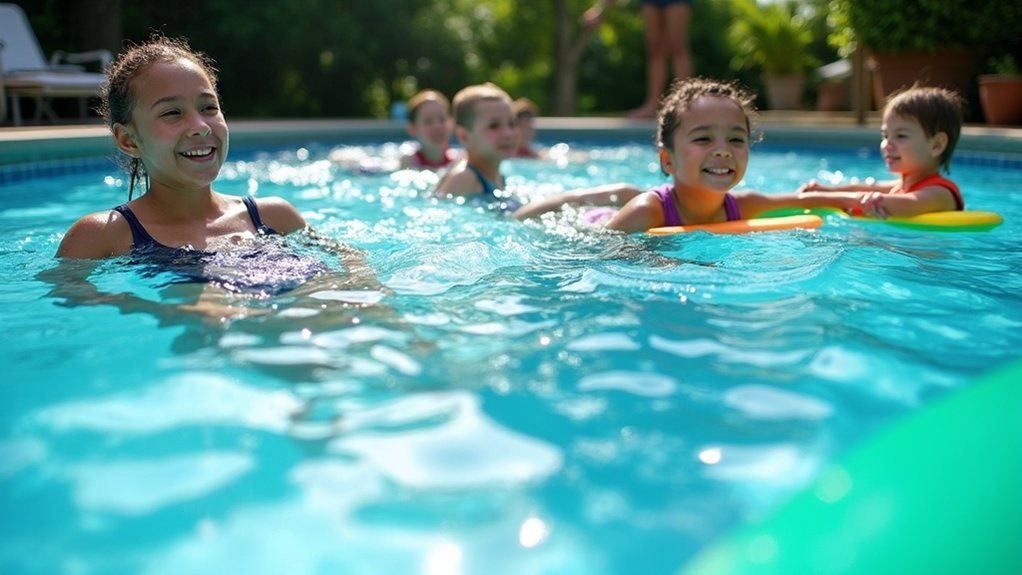



Leave a Reply